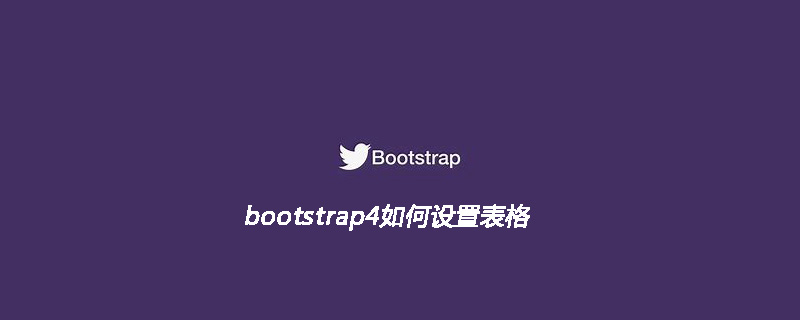

Table de base Bootstrap4
Bootstrap4 utilise la classe .table pour définir le style de la table de base. est la suivante :
Instance
<table class="table">
<thead>
<tr>
<th>Firstname</th>
<th>Lastname</th>
<th>Email</th>
</tr>
</thead>
<tbody>
<tr>
<td>John</td>
<td>Doe</td>
<td>john@example.com</td>
</tr>
<tr>
<td>Mary</td>
<td>Moe</td>
<td>mary@example.com</td>
</tr>
<tr>
<td>July</td>
<td>Dooley</td>
<td>july@example.com</td>
</tr>
</tbody>
</table>Table rayée
En ajoutant le .table-striped, vous verrez des rayures sur les lignes à l'intérieur de
, comme le montre l'exemple suivant :Instance
<table class="table table-striped"> <thead> <tr> <th>Firstname</th> <th>Lastname</th> <th>Email</th> </tr> </thead> <tbody> <tr> <td>John</td> <td>Doe</td> <td>john@example.com</td> </tr> <tr> <td>Mary</td> <td>Moe</td> <td>mary@example.com</td> </tr> <tr> <td>July</td> <td>Dooley</td> <td>july@example.com</td> </tr> </tbody></table>

Tableau bordé
.la classe bordée de table peut ajouter des bordures au tableau
Instance
<table class="table table-bordered"> <thead> <tr> <th>Firstname</th> <th>Lastname</th> <th>Email</th> </tr> </thead> <tbody> <tr> <td>John</td> <td>Doe</td> <td>john@example.com</td> </tr> <tr> <td>Mary</td> <td>Moe</td> <td>mary@example.com</td> </tr> <tr> <td>July</td> <td>Dooley</td> <td>july@example.com</td> </tr> </tbody></table>
Tableau d'état du survol de la souris
La classe .table-hover peut ajouter un effet de survol de la souris (fond gris) à chaque ligne du tableau :
Instance
<table class="table table-hover"> <thead> <tr> <th>Firstname</th> <th>Lastname</th> <th>Email</th> </tr> </thead> <tbody> <tr> <td>John</td> <td>Doe</td> <td>john@example.com</td> </tr> <tr> <td>Mary</td> <td>Moe</td> <td>mary@example.com</td> </tr> <tr> <td>July</td> <td>Dooley</td> <td>july@example.com</td> </tr> </tbody></table>
Tableau à fond noir
.la classe table-dark peut ajouter un noir arrière-plan du tableau :
Exemple
<table class="table table-dark"> <thead> <tr> <th>Firstname</th> <th>Lastname</th> <th>Email</th> </tr> </thead> <tbody> <tr> <td>John</td> <td>Doe</td> <td>john@example.com</td> </tr> <tr> <td>Mary</td> <td>Moe</td> <td>mary@example.com</td> </tr> <tr> <td>July</td> <td>Dooley</td> <td>july@example.com</td> </tr> </tbody></table>
Recommandations associées : "Tutoriel de mise en route Bootstrap"
Table à rayures noires
Utilisez les classes .table-dark et .table-striped ensemble pour créer une table à rayures noires :
Instance
<table class="table table-dark table-striped"> <thead> <tr> <th>Firstname</th> <th>Lastname</th> <th>Email</th> </tr> </thead> <tbody> <tr> <td>John</td> <td>Doe</td> <td>john@example.com</td> </tr> <tr> <td>Mary</td> <td>Moe</td> <td>mary@example.com</td> </tr> <tr> <td>July</td> <td>Dooley</td> <td>july@example.com</td> </tr> </tbody></table>
Effet de survol de la souris - tableau sur fond noir
Utilisez les classes .table-dark et .table-hover ensemble pour définir l'effet de survol de la souris du tableau à fond noir Effet d'arrêt :
Instance
<table class="table table-dark table-hover"> <thead> <tr> <th>Firstname</th> <th>Lastname</th> <th>Email</th> </tr> </thead> <tbody> <tr> <td>John</td> <td>Doe</td> <td>john@example.com</td> </tr> <tr> <td>Mary</td> <td>Moe</td> <td>mary@example.com</td> </tr> <tr> <td>July</td> <td>Dooley</td> <td>july@example.com</td> </tr> </tbody></table>
Spécifiez la couleur classe de signification
Pass La classe de couleur avec une signification spécifiée peut définir la couleur des lignes ou des cellules du tableau :
.table-primary蓝色: 指定这是一个重要的操作 .table-success绿色: 指定这是一个允许执行的操作 .table-danger红色: 指定这是可以危险的操作 .table-info浅蓝色: 表示内容已变更 .table-warning橘色: 表示需要注意的操作 .table-active灰色: 用于鼠标悬停效果 .table-secondary灰色: 表示内容不怎么重要 .table-light浅灰色,可以是表格行的背景 .table-dark深灰色,可以是表格行的背景
Couleur de l'en-tête du tableau
Dans Bootstrap v4.0.0-beta.2, la classe .thead-dark est utilisée pour ajouter un fond noir à l'en-tête du tableau, et le La classe .thead-light est utilisée pour ajouter un fond gris à l'en-tête du tableau :
Dans Bootstrap v4 .0.0-beta Dans cette version, la classe .thead-inverse est utilisée pour ajouter un fond noir au tableau en-tête, et la classe .thead-default est utilisée pour ajouter un arrière-plan gris à l'en-tête du tableau.
Table plus petite
.La classe table-sm est utilisée pour réduire le remplissage en réduisant le remplissage une table plus petite :
Instance
<table class="table table-bordered table-sm"> <thead> <tr> <th>Firstname</th> <th>Lastname</th> <th>Email</th> </tr> </thead> <tbody> <tr> <td>John</td> <td>Doe</td> <td>john@example.com</td> </tr> <tr> <td>Mary</td> <td>Moe</td> <td>mary@example.com</td> </tr> <tr> <td>July</td> <td>Dooley</td> <td>july@example.com</td> </tr> </tbody></table>
Table adaptative
Le .table La classe -responsive est utilisée pour créer des tableaux réactifs : lorsque la largeur de l'écran est inférieure à 992px, une barre de défilement horizontale sera créée. Si la largeur de la zone visuelle est supérieure à 992px, différents effets seront affichés (pas de barre de défilement) :
Exemple
<div class="table-responsive"><table class="table"> <thead> <tr> <th>#</th> <th>Firstname</th> <th>Lastname</th> <th>Age</th> <th>City</th> <th>Country</th> <th>Sex</th> <th>Example</th> <th>Example</th> <th>Example</th> <th>Example</th> </tr> </thead> <tbody> <tr> <td>1</td> <td>Anna</td> <td>Pitt</td> <td>35</td> <td>New York</td> <td>USA</td> <td>Female</td> <td>Yes</td> <td>Yes</td> <td>Yes</td> <td>Yes</td> </tr> </tbody></table></div>
Vous pouvez définir la barre de défilement pour qu'elle s'affiche sous la largeur d'écran spécifiée via les paramètres de classe suivants :
.table-responsive-sm< 576px .table-responsive-md< 768px .table-responsive-lg< 992px .table-responsive-xl< 1200px
Instance
<div class="table-responsive-sm"> <table class="table"> ... </table></div>
Ce qui précède est le contenu détaillé de. pour plus d'informations, suivez d'autres articles connexes sur le site Web de PHP en chinois!
 Que se passe-t-il lorsque phpmyadmin ne peut pas y accéder ?
Que se passe-t-il lorsque phpmyadmin ne peut pas y accéder ?
 Explication détaillée de la commande imp dans Oracle
Explication détaillée de la commande imp dans Oracle
 Comment télécharger Binance
Comment télécharger Binance
 Que signifie ajouter en Java ?
Que signifie ajouter en Java ?
 Comment ouvrir le fichier d'état
Comment ouvrir le fichier d'état
 Quelles compétences sont nécessaires pour travailler dans l'industrie PHP ?
Quelles compétences sont nécessaires pour travailler dans l'industrie PHP ?
 Situations courantes d'échec de l'index MySQL
Situations courantes d'échec de l'index MySQL
 Comment ouvrir le fichier php
Comment ouvrir le fichier php